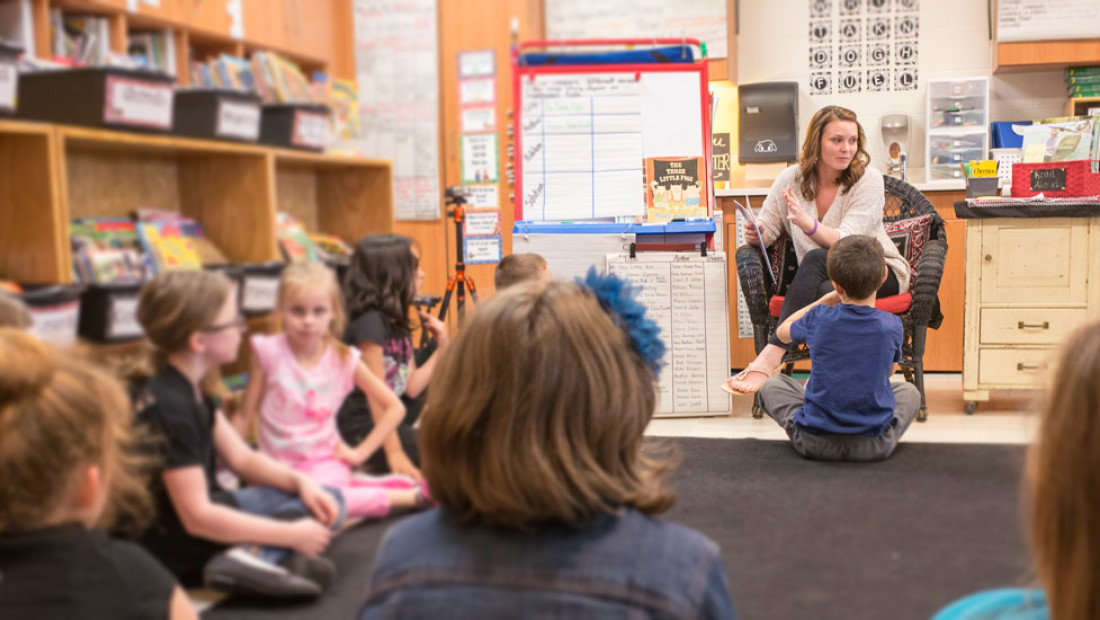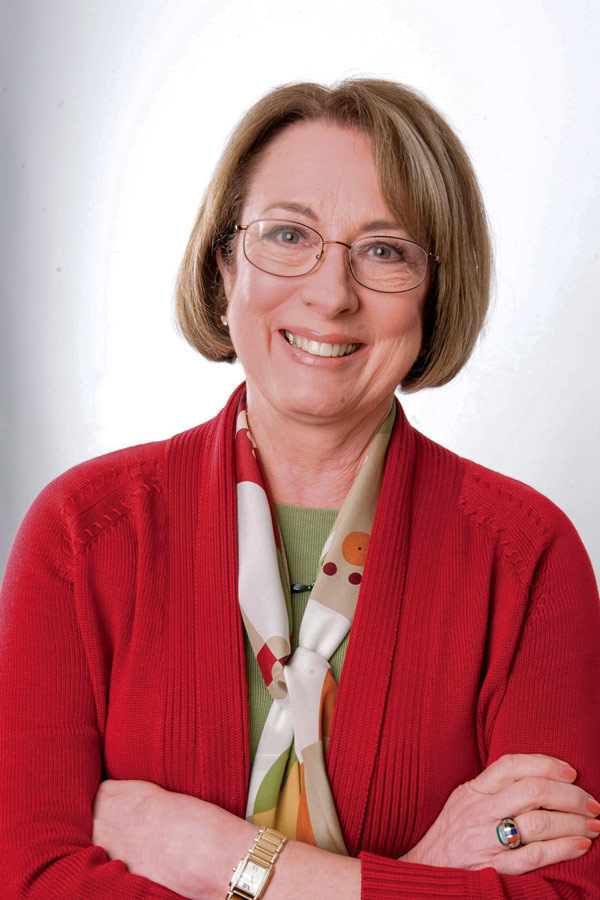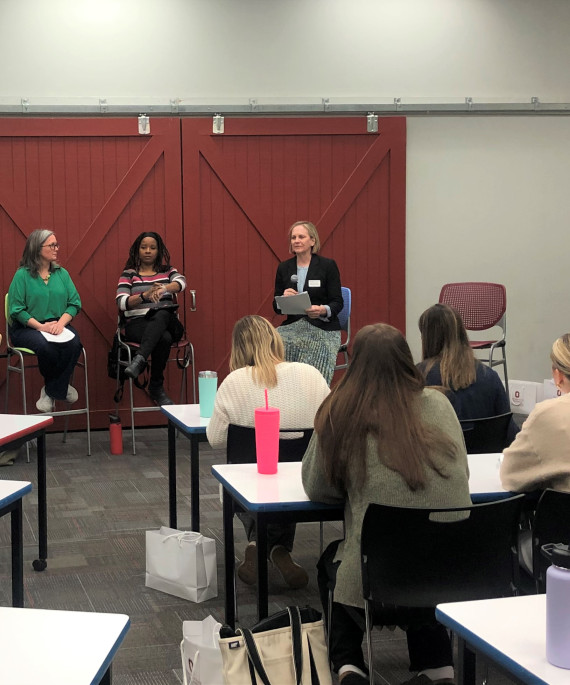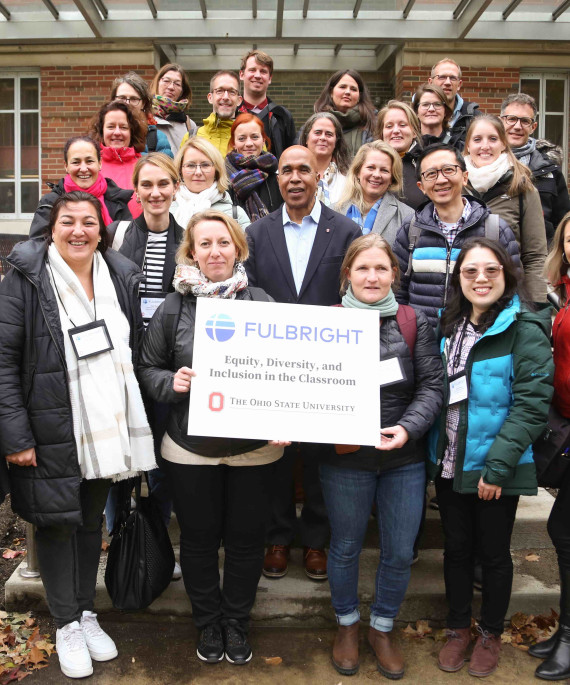
Literacy model trains classroom teachers to accelerate student learning
From her earliest years, Gay Su Pinnell cherished reading – so much that she dedicated her career to helping young children who struggled to learn to read.
Now, after giving $7.5 million to the college in July for children’s literacy, the professor emerita again shows her commitment to paying it forward. Her new $2 million gift supports Literacy Collaborative, the college’s comprehensive school literacy model for grades K-8.
Jamie Lipp, the college’s interim lead for Literacy Collaborative and Reading Recovery, calls the gift a blessing. “Not only will it help us be more financially secure, but it will allow us to grow and expand, have some flexibility. It’ll be used over five years to address needs within the project.”

Training in how to use the long-standing model in schools has been self-sustaining for decades. But with district budget cuts due to the pandemic, Pinnell’s gift will ensure a funding stream to sustain the college’s Literacy Collaborative trainers.
The trainers currently work with 25 school districts in five states, including Ohio. According to the most recent data, the coaches and teachers in the districts enhanced the learning of 8,640 students that academic year.
“Our society benefits when we have fully literate citizens,” said Don Pope-Davis, dean of the College of Education and Human Ecology. “By creating Literacy Collaborative, Dr. Pinnell has enriched our college’s reputation as a leader in supporting young children’s education. We appreciate her latest gift to keep Literacy Collaborative strong.”
Literacy Collaborative boosts whole-school literacy learning
“Teacher expertise, teachers' knowledge and skills, make more of a difference to student learning than any other single factor,” Lipp said. “Literacy Collaborative is an investment in teacher expertise. It provides long-term professional development, which is known to hone professional skills over time.”
Wendy Reed, a college-level Literacy Collaborative trainer, said the model does not assume there is only one way to teach. “The trainers guide coaches and teachers to be responsive based on learners’ strengths and needs,” she said. “We train them to recognize the assets kids bring to their learning, to gather data showing what each child is learning and to build on it.”
Joining the collaborative begins with training for a school building’s chosen literacy coach, who receives 230 hours over 12 to 15 months.
“Initial coach training is rigorous,” said Shelly Schaub, also a college-level Literacy Collaborative trainer, “yet districts come back year after year for ongoing professional learning.”
When the building coach is ready to move forward, the collaborative trains leadership at all levels of the building, from classroom teachers to administrators.
“As everyone becomes trained, they know it's not about learning to teach a particular program or curriculum,” Lipp said. “You are building their literacy understanding and creating expert teachers who are equipped and empowered to make instructional decisions and feel confident that those decisions are based on the needs of those learners.”

School moved from F to B in two years
Schools join the collaborative in a variety of ways and for different reasons. “Some realize their students are not making the gains they would like to see,” said Schaub. “Rather than purchasing a resource to hand to teachers, they decide to invest in teacher professional learning and tend to find their way to Literacy Collaborative.”
Southeast Primary School, serving K-2 in the Southeast City Schools District of rural Ravenna, Ohio, took this route. After two years as principal, David Fesemyer concluded that their talented, highly educated teachers were working incredibly hard for results that, based on data, didn’t align with the effort.
“Fifty percent of our kids were a grade level behind (in literacy development) when they came to us in kindergarten,” he said of the school’s approximately 300 students. “When they left … at the end of second grade, 50% were still behind.”
The district’s curriculum director, Kim Davis, recommended Literacy Collaborative.
Teacher buy-in is essential in adopting the collaborative. Fesemyer had built trust among his school’s teachers over the two years, and they liked the idea of an investment in their talent.
Plus, “he took all of the teachers ... to a school that was using Literacy Collaborative,” said Michelle Rentsch, previously the Southeast Primary literacy coach and now principal since Fesemyer’s retirement. “They could actually see the work being done in a classroom to make sure they felt, ‘Yes, we can see ourselves doing this.’”
Once trained, Rentsch said she gained access to the college’s trainers for questions, as well as “an amazing community of coaches in Ohio. It’s like a huge family of support,” she said. “My training at Ohio State was by far the best I ever had in my career.”
In a record two years, the district’s K-2 students catapulted from an F to a B in literacy, according to their state report card.
Since then, the students have received an A in their state report card for two years in a row. The Ohio Board of Education also presented the school with its All A Award.

Learning expands from literacy to social studies, science, math
In Literacy Collaborative, students spend a 2.5-hour block daily in literacy learning, including interactive read aloud, reading workshop, writing workshop, guided reading and word study.
“Our kids have always loved reading books,” Rentsch said, “but now, the way they talk about authors, you would think they know them personally. (It’s) because they’ve done author studies … and they’ve read every one of their books and had book talks. Those conversations have gone to a deeper level with our students.”
The Southeast teachers also integrate social studies and science reading within the literacy block, so students make connections. The collaborative has even impacted the school’s math program, which they now teach in small groups using activities and shared exploration. This approach helps students gain understanding and build meaning.
“It’s a similar model to what we do in Literacy Collaborative,” Rentsch said, “because we’ve seen how powerful it is.”
The Newark City School District has worked with Literacy Collaborative since 1995, not long after Pinnell and colleagues trained the first coach in 1993. Since that time, the district has maintained its own coach trainer. Denise Rowe took on that role in 2015.
In addition to the college’s twice-yearly training for Newark’s coaches, Rowe provides ongoing professional development for the two Newark coaches at each of their seven elementary schools.
Rowe feels her work with the coaches brings ongoing benefits, including “instructional rounds” in which she models a lesson, then teachers practice it. “It’s being able to support teachers with cutting-edge research, fresh knowledge and how to implement it in their classrooms,” she said.
Thanks to the collaborative, the district’s third-grade reading scores have doubled their growth rate in the last three years compared to similar districts. They continue to trend upward to meet state expectations.
Rentsch said Pinnell visited their district in April 2019, showing that she truly cares about the schools using the literacy framework that she spent so many years developing and perfecting through research.
Rowe said that since joining the Newark district early in her career, everything she’s known has been based on Pinnell’s work. “What a blessing (it is) to have her impacting so many teachers and coaches and professionals and students,” Rowe said. “Her work is just so far reaching.”
Heart full of gratitude for Gay Su Pinnell. Not surprised by her incredible generosity. That’s who she is. I count it a privilege to have learned so much from her over the last 15 years. My colleagues and I will proudly continue the legacy she created at Literacy Collaborative https://twitter.com/rrcna_org/status/1281267805204119553
— Sherry Kinzel (@SherryKinzel) July 10, 2020
College-level Literacy Collaborative trainer Sherry Kinzel said her heart was full of gratitude for Pinnell’s gift on Twitter. “I count it a privilege to have learned so much from her over the last 15 years,” Kinzel wrote. “My colleagues and I will proudly continue the legacy she created at Literacy Collaborative.”
Read more about Pinnell's generosity for children's literacy: Professor emerita donates $7.5M to EHE, largest individual gift in college’s history




